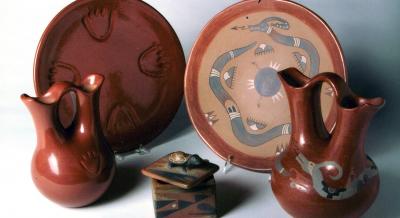Visual Experiences: Born of Fire
This exhibition of the famed American potter, Margaret Tafoya, has been one of the longest running local exhibitions in memory, with the closing date being postponed a number of times. When I asked a representative of the Erie Art Museum why that is, she responded, ?The show?s closing has been pushed back so many times because it?s a great show?we didn?t want to take it down.? A handsome show it is, and here is your chance to see why exactly they were so reluctant to make room for another exhibition.
This exhibition of the famed American potter, Margaret Tafoya, has been one of the longest running local exhibitions in memory, with the closing date being postponed a number of times. When I asked a representative of the Erie Art Museum why that is, she responded, "The show's closing has been pushed back so many times because it's a great show—we didn't want to take it down." A handsome show it is, and here is your chance to see why exactly they were so reluctant to make room for another exhibition.
Margaret Tafoya (1904 to 2001) came into the world of Native American pottery at a critical juncture. The Santa Fe Railroad arrived (c.1880 to 1885) bringing cheaper and sturdier cookware than that regionally made, and the first local wells were dug (c. 1916), making sturdy water pots for transport unnecessary. Tourists, brought in by the railroad, became interested in small portable pieces as souvenirs, which helped to keep the otherwise outmoded art form alive.
Later serious collectorship began, and pieces corresponding to the demand were created. For example, wedding jars - double-spouted vessels from which the bride and groom were to drink - originally were relatively small, and not many of the early examples exist, as they were usually destroyed as part of the wedding. But these graceful forms became popular among collectors, resulting in jars too large to actually use and fired at a temperature too low to make them practical.
Margaret Tafoya was born into a family of potters with a rich heritage, and in 1924, she married Alcario Tafoya, also of a potting family, beginning a 71-year collaboration. Their children, all of whom are gifted potters, are each unique in their own way while still being traditional.
"I don't want this pottery to die," she once said, and her actions went a long way to ensuring that it didn't. The young Margaret learned the coil method of pottery from watching her mother, just as her mother had done, and eventually developed a precision and skill that gives the appearance that these pieces could have been made on a wheel. They were then burnished with a stone to give the high gloss finish, before firing.
Just as the Tafoyas continue to use local clay, they resist firing in electric kilns, preferring traditional wood fires. This is a tricky process as the fire gives them only a 30 second window before the high gloss is lost.
The Tafoyas sense a spiritual energy in the clay and in their process. They respect the earth and make sure none of the clay goes to waste. As Margaret Tafoya said, "Listen to Mother Clay. Mother Clay is shaping the pot."
Some of these black and red ware pots are painted with slip (clay mixed with water) ornamentation, but most are enhanced with cut and incised designs. Some have the abstract bear claw motif, the trademark of the Tafoya Clan, which, with the simple but elegant shapes has a modern look that appeals to collectors. Some have a band of decoration, deeply cut, with traditional symbols. In red clay the undercutting has an off-white appearance; and with the black, a gray cast, setting off the highly burnished design.
One of the symbols that frequently reoccur is the "Avanyu" or water serpent. Perhaps one reason for Margaret Tafoya's fascination with this design is that she claimed to have seen one of these creatures. They are said to be illusive, but if you are lucky enough to spot one, you will have a long life (she lived to be 108 years old).
The gallery is filled with helpful posted information, as well as photos and even diagrams identifying the various symbols that occur on the pottery.
This exhibit is a testimony to human nature, that even in making something utilitarian, there is a fundamental need to create beauty as well.
As Margaret Tafoya observed, "You have to have a good heart when you sit down to make this pottery; you have to live a good life. The pottery knows."
This exhibition continues through Sept. 30 at the Erie Art Museum on the ground floor of the Customs House, 411 State St., new entrance for the Erie Art Museum is Fifth Street between State and French streets. Hours: Tuesday through Thursday, 11 a.m. to 5 p.m.; Friday 11 a.m. to 9 p.m.; Saturday 11 a.m. to 5 p.m.; and Sunday 1 to 5 p.m.
Want to comment on this story? Click here!


.png)
